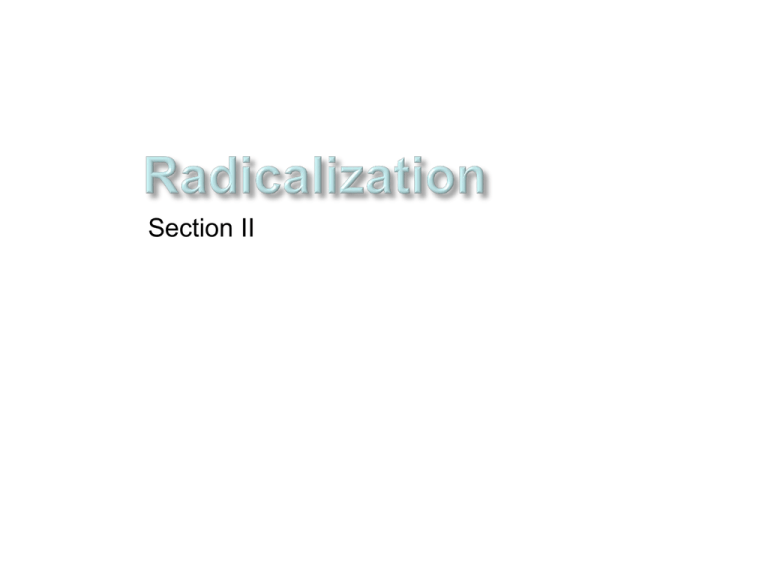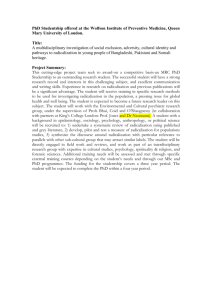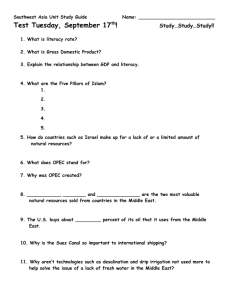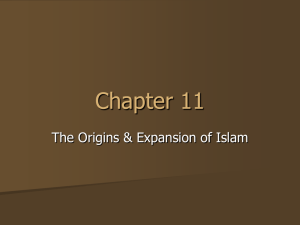Pre-Radicalization - The Anti-Money Laundering Association
advertisement

Section II • Homegrown Terrorism. Ex. Daniel Patrick Boyd. • Growing importance. Intelligence services and experts see “homegrown terrorism” as a growing threat due to the increasing number of Westerners embracing militant Islam, coupled with the operatives’ familiarity with the societies they are targeting and ease of mobility. • • • • • Conventional wisdom: Poverty as “root cause.” Hate crimes analogy. Public opinion surveys: Higher education levels more likely to say suicide attacks justified against Americans and Westerners. Participation in terrorist groups. Marc Sageman: Not crazy, not suffering from personality disorders. • In August 2007, the NYPD released an important study on radicalization • Four phases homegrown terrorists go through: – Pre-Radicalization – Self-Identification – Indoctrination – Jihadization • Like a funnel • • • • Pre-Radicalization: Individual’s life before accepting radical beliefs. Apparent normalcy. Self-identification: Begin to explore Salafi Islam and associate with the like-minded; often caused by cognitive opening. Indoctrination: Where an individual “progressively intensifies his beliefs, wholly adopts jihadi-Salafi ideology and concludes, without question, that the conditions and circumstances exist where action is required to support and further the cause. That action is militant jihad.” Jihadization: Action phase. • Sageman, Post: It’s not how they think, it’s how they feel. • April 2009 study, Homegrown Terrorists in the U.S. and U.K.: An Empirical Examination of the Radicalization Process. • Examines external signs in 117 homegrown terrorists. • Steps: - Adopting a legalistic interpretation of the faith - Trusting only select, ideologically rigid religious authorities - Perceived schism between Islam and the West - Low tolerance for perceived theological deviance - Attempts to impose religious beliefs on others - Political radicalization • Countercultural upbringing. – Gadahn’s parents decided to eschew America’s consumerist lifestyle in favor of austere isolation and self-sufficiency. – Gadahn’s family lacked (by choice) a telephone, mailing address, and even a toilet in their home. • In his teens, Gadahn became obsessed with death metal. – Gadahn: “My entire life was focused on expanding my music collection. I eschewed personal cleanliness and let my room reach an unbelievable state of disarray.” – Formed a one-man death metal band called Aphasia. • After going through a period where he felt “empty” and explored evangelical Christian radio, Gadahn became Muslim. • Small group: Gadahn soon fell in with a small group of men who held evening discussion groups in the mosque. • These men “wore turbans, long robes and long beards, and they spent a lot of time criticizing other members of the mosque.” • Legalistic. Zena Zeitoun: “Everything was haram to them in the United States. If they saw a girl walking down the street in a short skirt, that’s haram. If they saw you with a beer bottle in your hand, that’s haram. If they saw a man and a woman holding each other, that’s haram.” • Gadahn began to adopt legalism early on. • Gadahn’s outward signs – Stopped shaving. – Gave up music. – Began to wear sandals with Saudi style robes or an Afghanstyle shalwar kameez • Gadahn complied with group members’ instructions – Told Gadahn to stop wearing jeans – Women making tea. – Hisham Diab and Khalil Deek called Gadahn their “little rabbit.” – “He took everything [they] said as the Holy Grail.” -Saraah Olson, Diab’s ex-wife • Gadahn began to radicalize politically during this period. • Legalsim blended into his political radicalization, as his companions lectured just as naturally about global politics as about the need to stop wearing jeans. • Olson and her son Ryan described a cult-like atmosphere in which Gadahn was not even allowed to speak with his own family, and was told that “if you’re a good believer, you’ll kill them.” • The small group called mosque leader Haitham Bundakji “Danny the Jew” because of his moderate practice of Islam: “He’s a weak Muslim, he’s friends with Jews, he goes to Baptist churches, he hangs out with the police department—he’s just an awful Muslim.’” • When Bundakji mildly reprimanded Gadahn, Gadahn punched Bundakji in the face. Later pled guilty to misdemeanor assault and battery. Haitham Bundakji, President of the Islamic Society of Orange County • As he radicalized, Gadahn came to see Islam and the West as irreconcilably opposed. He isolated himself from non-Muslim family members, tried to block out the Western world. • Gadahn’s small apartment near the mosque was symbolic of this. Described as a “dungeon” by Zena Zeitoun, the apartment’s only decorations “were Islamic sayings of the Prophet” on the walls, “and a timetable for salat.”Walked to the mosque for prayers, did little else. • Gadahn later expressed the idea of a fundamental schism in his first video for al-Qaeda, saying that “the allegiance and loyalty of a Muslim is to Allah, his Messenger, his religion and his fellow believers before anyone and anything else…. If there is a conflict between his religion and his nation and family, then he must choose the religion every time.” NYPD Study Radicalization Timeline Jihadization Indoctrination Self-Identification Pre-Radicalization When viewed in the context of the NYPD Study, our model focuses primarily on activity taking place in the self-identification and indoctrination stages. Time Lapse ATTACK • • • • Legalistic interpretation generally comes in step 2 of the NYPD study, selfidentification. A legalistic interpretation of Islam refers to how believers interpret their rights and obligations in relation to Islam’s holy texts. An individual who has a legalistic interpretation of the faith has adopted a rules-based approach to the religion, in which the Qur’an and sunnah provide strict guidelines—not just for the practice of the faith, but also for virtually every aspect of one’s daily life. For many homegrown terrorists, developing a legalistic interpretation of the faith is the foundational step for other movements toward radicalism. High degree of prevalence. About half of the homegrown terrorists examined in our study exhibited this aspect of the radicalization process: of the 117 individuals surveyed, 57 (48.7%) had adopted a legalistic interpretation. We could only determine that individuals had not embraced a legalistic interpretation in four cases. • • • Lackawanna Six: Kamal Derwish, Juma al-Dosari. Fort Dix Six. Duka brothers became much more legalistic two or three years before their plot began. A cousin: “They were praying different, they were talking different, they were telling people what to believe.” The cousin refused to attend Eljvir Duka’s wedding when he learned that no music would be played. • Between stages 2 and 3 of the NYPD’s model (selfidentification and indoctrination), individuals frequently begin to trust only a certain set of Salafi-jihadi religious scholars, and see other Islamic scholars as inauthentic. – Trusting only certain scholars also implies the inverse step of rejecting many scholars (more liberal) as not conveying true Islam. • FDD’s study found evidence of this manifestation of the radicalization process in nearly one-third of the homegrown terrorists surveyed (30.8%), with only seven instances where it was clearly not present. • Daniel Maldonado’s blog spoke of his admiration for Abdul Wahhab, Ibn Taymiyya, Safar al-Hawali • Mohammad Bouyeri confronts his old imam: “I’ve come to tell you what the real Islam is. You don’t tell the truth.” Daniel Joseph Maldonado • Doctor, 2007 Glasgow bombings • Shiraz Maher, former member of Hizb ut-Tahrir: “Bilal said ‘Look, you’d better start praying and stop playing.’ He was adamant about it and put on this DVD of [Abu Musab] al-Zarqawi beheading a hostage. He said ‘If you don’t change, this is what we do. We slaughter.’” • Muriel Degauque: Would not allow her visiting parents to watch TV, drink alcohol. Separation of gender. • Jason Walters (Netherlands) and brother—living with their mother—would not allow her to drink or watch TV. In the summer of 2003, she felt so threatened that she called the police. Muriel Degauque Section III I. Centralized vs. Decentralized II. Transnational Crime and Terror III. Oil and Terror IV. Somalia V. Terrorism as Political Protest • These opposing trends are occurring simultaneously. • Centralized command: Decisions filter from top to bottom. Examples: IRA, pre-9/11 al-Qaeda. • Decentralized: Little control from the top, more autonomy. Al-Qaeda Case Study • Before 9-11, al-Qaeda was centralized with a supreme leader (bin Laden), a shura (consultation) council, various committees, and a cadre of lieutenants in charge of regions or cells. – HARMONY documents • After losing its safe haven in Afghanistan and operating in a decentralized manner for several years, al-Qaeda’s senior leadership regrouped in Pakistan. It is now acting more like a centralized organization again. • Importance of central leadership. • The ultimate example of decentralized action. • Examples of lone wolf terrorism in the U.S. – July 4, 2002: Hesham Mohamed Hadayet. – March 3, 2006: Mohammed Reza Taheri-azar. – July 2006: Naveed Haq, Seattle Jewish Federation building. He said that he was upset about U.S. support for Israel and the Iraq war. – 2009: Holocaust Museum shooting. • Connections between transnational crime and terrorism are deepening. • Roots in Soviet Union’s collapse. • Advantages to terrorists; converse advantages to law enforcement. “Al Capone model.” • Drug trafficking: Hizballah • Financial scams: identity theft, bank fraud (i.e. credit card fraud), cigarette smuggling, counterfeiting (clothes, cigarette rolling papers, Viagra) • Immigration fraud (i.e. sham marriages) • Money laundering/illegal money transfers • • Aribtrage scheme. Bob Fromme, deputy sheriff, JR’s Tobacco. • One day he noticed four olive-skinned young men were buying huge numbers of cigarettes. There was nothing wrong with this, except that each bought exactly 299 cartons, one less than the number that would require paperwork. One man paid for everything in cash; entire transaction cost close to $30,000. This became a regular pattern. Fromme tailed the vans to the state line, and watched as the drivers crossed north into Virginia, or west into Tennessee. Fromme called a friend and ATF. His friend told him that the men were smuggling cigarettes. • • • • • • • • ATF began around-the-clock surveillance. Soon the ATF established that the smuggling ring involved more than a dozen Arabs who had settled into middle-class Charlotte neighborhoods. Each smuggling van led a secret motorcade of five ATF cars. The cars would take turns following so that no vehicle was in the smugglers’ rearview mirror for too long. The agents sometimes changed clothes, switched license plates. Investigators found that the smugglers didn’t seem to spend much of the money. Where were all the profits going? Brothers Mohamad Hammoud and Chawki Youssef Hammoud would buy van loads of cigarettes in North Carolina, where the tax was 5 cents/pack, and sell them in Michigan, where the tax was 75 cents/pack. Profits to Hizballah. Also sham marriage. • At its peak, Al Haramain had offices in more than fifty countries and an annual budget of $30–80 million. • Al Haramain’s U.S. branch and two of its directors were indicted in January 2005 for illegally moving money out of the country. Central to the prosecution was the requirement that anyone who transports more than $10,000 in or out of the U.S. is required to provide details in Form 4790. • • • • • In February 2000, an Egyptian man wire transferred about $150,000 to an Al Haramain bank account in Ashland. In an e-mail, the donor stated that the money was designed “to participate in your noble support to our muslim brothers in Chychnia.” Shortly after, Al Haramain director Soliman al-But’he flew from Saudi Arabia to the U.S., where he met another director, Pete Seda. On March 10, the two men went to a branch office of Bank of America and bought 130 American Express traveler’s checks, all in the $1,000 denomination. Seda also collected a $21,000 Bank of America cashier’s check. Left without declaring; inflated value of building purchased in New Jersey. Lessons: – Why did al-But’he fly from Saudi Arabia to Oregon to pick up the check? – Example of “Al Capone” model at work. • Bin Laden’s shift. From declaring it off limits to urging operatives “focus your operations on it.” • Zawahiri, Sawt al-Jihad. • Actual targeting: Feb. 2006 Aramco attack using Aramco uniforms and vehicles. • Impact: Prices, wars, ripple effect. (And funding terrorists.) • Can we change oil as currency? • Many young Somalis living in the U.S. and elsewhere have left and joined alShabaab. Minneapolis-St. Paul. • Shirwa Ahmed, October 2008. Came to the U.S. in 1995, graduated from Roosevelt High School in 1999. • September 2009: Troy Kastigar sixth American killed in Somalia. • • • Following bombings that targeted gas pipelines operated by Canadian company EnCana, one observer noted that such attacks are “almost like the price of doing business.” Do some segments of the population accept that violence is a justifiable response to views or actions with which they strongly disagree? And will it grow deadlier over time? • Understanding ideology, radicalization, emerging trends important. • We’re all on the front lines now.








